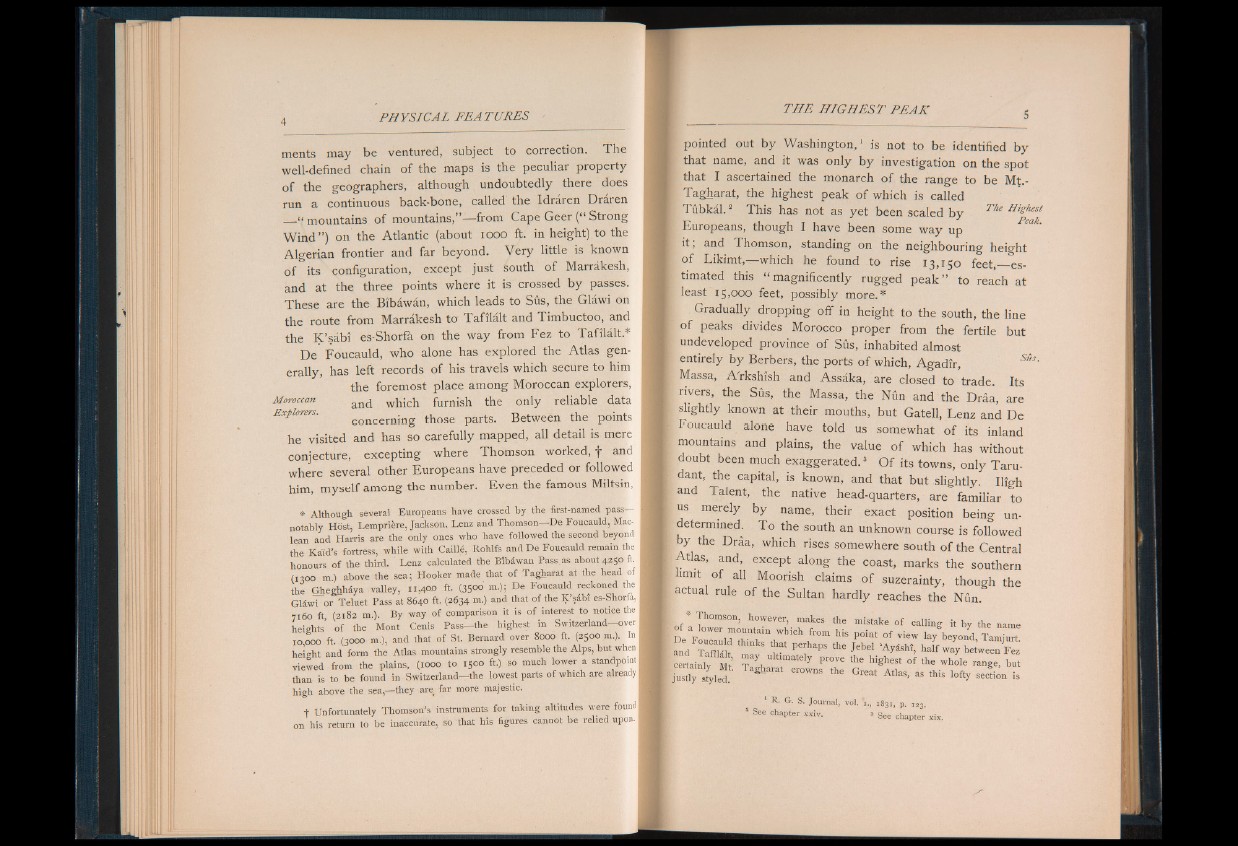
ments may be ventured, subject to correction. The
well-defined chain of the maps is the peculiar property
of the geographers, although undoubtedly there does
run a continuous back-bone, called the Idraren Draren
« mountains of mountains,”— from Cape Geer (“ Strong
W ind” ) on the Atlantic (about iooo ft. in height) to the
Algerian frontier and far beyond. Very little is known
of its configuration, except just south of Marrakesh,
and at the three points where it is crossed by passes.
These are the Bîbâwân, which leads to Sûs, the Glâwi on
die route from Marrakesh to Tafilalt and Timbuctoo, and
the K ’sâbî es-Shorfà on the way from Fez to Tafilalt.*
De Foucauld, who alone has explored the Atlas generally,
has left records of his travels which secure to him
the foremost place among Moroccan explorers,
Moroccan and which furnish the only reliable data
Explorers. concerning those parts. Between the points
he visited and has so carefully mapped, all detail is mere
conjecture, excepting where Thomson worked, f and
where several other Europeans have preceded or followed
him, myself among the number. Even the famous Miltsin,
* Although several Europeans have crossed by the first-named pass
notably Host, Lemprière, Jackson, Lenz and Thomson De Foucauld, Mac-
lean aud Harris are the only ones who have followed the second beyond
the Raid’s fortress, while with Caillé, Rohlfs and De Foucauld remain the
honours of the third. Lenz calculated the Bîbâwan Pass, as about 4250 ft.
(1300 m) above the sea; Hooker made that of Tagharat at the head of
the Gheghhaya valley, II,4° ° (3500' m.); De Foucauld reckoned the
Glâwi or Teluet Pass at 8640 ft. (2634 m.) and that of the K ’sâbî es-Shorfa,
7160 ft (2182 m.). By way of comparison it is of interest to notice the
heights’ of the Mont Cenis Pass— the highest in Switzerland— over
10,000 ft. (3000 m.), and that of St. Bernard over 8000 ft. (2500 m.). In
height and form the Atlas mountains strongly resemble the Alps, but when
viewed from the plains, (1000 to 1500 ft.) so much lower a standpoint
than is to be found in Switzerland— the lowest parts of which are already
high above the sea,— they are far more majestic.
f Unfortunately Thomson’s instruments for taking altitudes were found
on his return to be inaccurate, so that his figures cannot be relied upon.
I pointed out by Washington,1 is not to be identified by
E that name, and it was only by investigation on the spot
that I ascertained the monarch o f the range to be Mt.-
I Tagharat, the highest peak o f which is called
I Tubkal.3 This has not as yet been scaled by The His,iest
I Europeans, though I have been some way up
: it i and Thomson, standing on the neighbouring height
j of Likimt,— which he found to rise 13,150 feet, estimated
this “ magnificently rugged p e a k ” to reach at
least 15,000 feet, possibly more.*
Gradually dropping off in height to the south, the line
of peaks divides Morocco proper from the fertile but
undeveloped province o f Sus, inhabited almost
entirely by Berbers, the ports o f which, Agadir, S&sr
Massa, A'rkshish and Assaka, are closed to trade. Its
i rivers, the Sus, the Massa, the Nun and the Draa, are
j slightly known at their mouths, but Gatell, Lenz and De
: Foucauld alone have told us somewhat o f its inland
mountains and plains, the value of which has without
doubt been much exaggerated.3 O f its towns, only Taru-
dant, the capital, is known, and that but slightly. Iligh
and Talent, the native head-quarters, are familiar to
us merely by name, their exact position being undetermined.
To the south an unknown course is followed
j by the Draa, which rises somewhere south of the Central
Atlas, and, except along the coast, marks the southern
limit of all Moorish claims o f suzerainty, though the
actual rule o f the Sultan hardly reaches the Nun.
* Thomson, however, makes the mistake of calling it by the name
of a lower mountain which from his point of view lay beyond T am ta
and T a f lu i H H H | j the Jebel [ E £ halfway between Fez
certainly Mt U Prave the highest of the whole range, but
P P P Ta£harat CrOWDS the Great A * * « this lofty section is
1 R. G. S. Journal, vol. r., 1831, p. 123.
a See chapter xxiv. 3 See chapter xix.